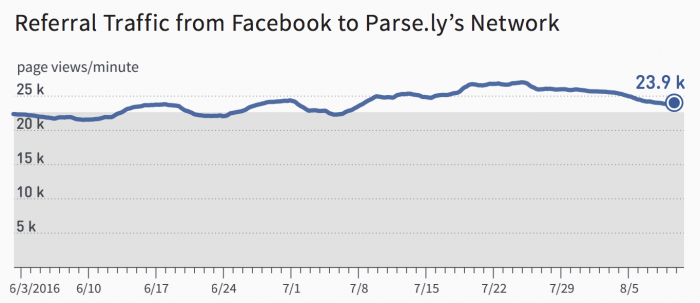
When Facebook announced in June that it was tweaking its News Feed algorithm — giving more weight to friends and family and less to publishers and brands — fear levels at news organizations were high. Editors stood watchful for any change in incoming Facebook traffic, ready to blame any drop on the platform.
But more than a month in, the Facebookpocalpyse seems to have been averted. New data from analytics firm Parse.ly finds that Facebook traffic to its network of publishers has been flat or even slightly up since the June 29 announcement. There hasn’t been any noticable change after Facebook’s August 4 announcement it was clamping down on clickbait either, although it may be a little early to know the full impact of that change.

Parse.ly’s network of sites includes more than 600 digital publishers, including many big names (Upworthy, Slate, The Daily Beast, Business Insider), so its experience is likely to be representative of news media more broadly. In its network, Facebook passed Google as the top source of traffic last summer; as of earlier this year, Facebook was generating more than 40 percent of referrers to network sites.Neither of the announcements have had a measurable traffic impact on digital publishers so far. At the time of publishing, it looks like referrals have increased since the initial announcement.
The Facebook data was included in Parse.ly’s latest report, which focuses on the role of the homepage on publisher sites, something some have been busy declaring dead for several years, ever since The New York Times’ Innovation report reported a significant drop in homepage traffic.
On one hand, the homepage-as-traffic-distributor is still a much weakened force, thanks to social media. For the majority of Parse.ly network sites, less than 10 percent of referrers to article pages come from the site’s homepage.

But the report did highlight the homepage’s predictive power in whether a particular story will take off on social. According to Parse.ly, once a story linked on your homepage reaches 500 total pageviews from social and the homepage combined, you can predict with significant accuracy whether or not it will be a social hit. In other words, homepage-dominant stories rarely go supernova on social, and social-dominant stories rarely become homepage-dominant.

Thus, if your goal is to use a particular slot on your homepage to drive social, you can do so by placing a new article in it and checking in early on to determine which category it falls into. If it’s a social-positive article, great—leave it there as long as it’s timely. If it’s social-negative, though, you should remove the article from the slot and try your luck featuring a new article.
There’s more detail about Parse.ly’s homepage analysis in the full report.